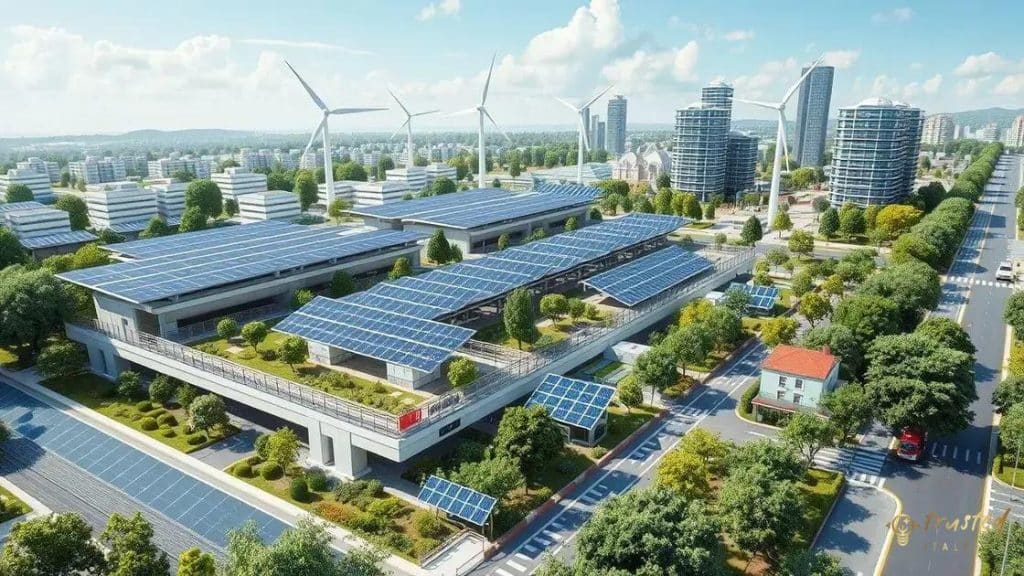Investment opportunities in sustainable infrastructure projects

Investment opportunities in sustainable infrastructure projects include renewable energy, green building, and sustainable agriculture, aiming to yield financial returns while addressing environmental and community needs.
Investment opportunities in sustainable infrastructure projects are gaining traction as more people seek ways to contribute to a sustainable future. Have you considered how these projects can benefit both the environment and your portfolio? Let’s dive into this compelling topic.
Understanding sustainable infrastructure
Understanding sustainable infrastructure is essential in today’s world, where climate change and environmental degradation are pressing issues.
Sustainable infrastructure refers to the design and construction of facilities that meet present needs while ensuring future generations can meet theirs.
Such efforts aim to create eco-friendly systems that contribute positively to both society and the environment.
What Makes Infrastructure Sustainable?
Sustainable infrastructure integrates various solutions to minimize negative impacts. This includes using renewable energy sources, reducing waste, and utilizing sustainable materials. Green buildings, for example, are built to consume less energy and use sustainable resources without compromising comfort.
Key Components of Sustainable Infrastructure
- Energy Efficiency: Homes and buildings are designed to use less energy, reducing costs and emissions.
- Renewable Resources: Projects incorporate solar, wind, and geothermal energy sources.
- Water Management: Sustainable designs emphasize clean water practices and conservation.
- Waste Reduction: Efforts focus on recycling and reusing materials to minimize landfill waste.
Understanding sustainable infrastructure means recognizing the importance of community involvement. Engaging citizens in decision-making encourages better outcomes and fosters deeper connections between people and their environment. When communities are actively involved, projects are more likely to meet their needs and priorities, leading to successful long-term benefits.
Investment in sustainable infrastructure not only addresses immediate environmental challenges but also creates jobs, supports local economies, and enhances quality of life. The combination of innovative technology and community engagement results in infrastructure that is resilient and adaptable to changing circumstances. As more people become aware of these benefits, the demand for sustainable solutions continues to grow.
Key benefits of investing in green projects

Investing in green projects yields many benefits for investors and the environment alike. As climate change becomes a larger concern, the shift toward sustainable practices also opens new avenues for profit. Within this context, recognizing the key advantages of these investments is crucial.
Environmental Protection
One primary benefit of investing in green projects is their positive impact on the environment. By supporting renewable energy initiatives, you help reduce greenhouse gas emissions. Projects such as wind farms and solar energy plants contribute significantly to cleaner air and a healthier planet.
Economic Growth
Green investments also drive economic development. They create new job opportunities in various sectors, including construction and renewable energy. As the demand for sustainable technologies increases, so does the potential for economic expansion.
- Job Creation: Green projects often create numerous skilled jobs.
- Innovation: Investing in green technologies spurs creative solutions for modern challenges.
- Local Development: Sustainable projects help boost local economies and improve infrastructure.
Moreover, investors often experience financial returns when they join the movement toward sustainability. Many green projects can offer attractive financial incentives, such as grants and tax benefits. Investing in clean energy technologies often leads to reduced operational costs over time, enhancing overall profitability.
Another notable advantage of green projects is their capacity for promoting social responsibility. Investors are increasingly aware that supporting environmentally friendly initiatives aligns with their core values. By backing these projects, individuals and organizations contribute positively to their communities and help foster a sustainable future. This kind of involvement can enhance a company’s reputation and foster loyalty among customers who prioritize sustainability.
Top sectors for sustainable investment
Identifying the top sectors for sustainable investment is crucial for both environmental and financial success. Investors seeking to make a positive impact while growing their portfolios can focus on certain industries leading the way in sustainability. These sectors not only promise potential profits but also contribute to a healthier planet.
Renewable Energy
One of the most prominent areas for sustainable investment is renewable energy. This includes solar, wind, and hydro power projects. Investing in renewable energy helps reduce reliance on fossil fuels and lowers overall carbon emissions. The renewable energy sector has witnessed remarkable growth, and forecasts predict continued expansion as technology improves and demand increases.
Sustainable Agriculture
Another key sector is sustainable agriculture. This includes farming practices that are environmentally friendly and support biodiversity. Sustainable agriculture focuses on using organic methods, which improve soil health and reduce chemical usage. Investing in this sector contributes to food security and can yield significant returns as organic food demand rises.
- Innovative Farming: Technologies like vertical farming and hydroponics improve efficiency and use less land.
- Agroforestry: Combining agriculture and forestry can enhance biodiversity and restore ecosystems.
- Local Food Systems: Supporting local producers can reduce transportation emissions and enhance community resilience.
Green building and construction is also rapidly evolving and offers numerous investment opportunities. Green buildings are designed to be energy-efficient and eco-friendly. This sector incorporates sustainable materials, efficient designs, and renewable energy integration, resulting in lower operating costs and increased property values. As society becomes more conscious of environmental impacts, demand for green buildings continues to rise.
The transportation sector, particularly electric vehicles (EVs), is another promising area for sustainable investment. The shift to EVs helps reduce greenhouse gas emissions from fossil fuel-powered vehicles. Investing in companies that manufacture electric vehicles, battery technologies, and supportive infrastructure, like charging stations, can yield substantial benefits as adoption rates increase.
How to assess project viability

Assessing project viability is essential before investing in sustainable initiatives. Understanding how to evaluate a project helps ensure that resources are allocated effectively. This process involves various steps and considerations to maximize success.
Feasibility Studies
The first step in assessing viability is conducting a feasibility study. This study evaluates critical factors such as technical, economic, and legal aspects of the project. By identifying potential challenges early, investors can make informed decisions about whether to proceed.
Economic Assessments
Understanding the financial aspects is crucial for any investment. Investors must analyze projected returns, costs, and funding sources. Key considerations include initial capital requirements, ongoing operational expenses, and potential revenue streams. Creating a detailed financial model can provide insights into the project’s long-term sustainability.
- Return on Investment (ROI): Calculate the expected ROI to gauge profitability.
- Cost-Benefit Analysis: Weigh the costs against projected benefits to assess overall value.
- Funding Sources: Identify possible grants, loans, and incentives that could alleviate financial burdens.
Another important aspect is assessing the technical feasibility of the project. This involves evaluating if the technology required is available and reliable. Given the rapid evolution of sustainable technologies, staying current is critical. Investors should also consider the project team’s qualifications and experience related to the initiative.
Environmental impact assessments are necessary to ensure compliance with local regulations and sustainability goals. Understanding the potential effects on the surrounding ecosystem helps mitigate risks and enhances a project’s acceptance within the community. Engaging stakeholders throughout the assessment process can foster collaboration and address concerns early on.
Future trends in sustainable infrastructure
Future trends in sustainable infrastructure are shaping the way communities develop and grow. As the demand for greener solutions increases, new technologies and practices are emerging to address environmental challenges. Understanding these trends helps investors and stakeholders stay ahead in the evolving landscape of sustainability.
Smart Technology Integration
One significant trend is the integration of smart technologies in infrastructure projects. Smart grids, sensors, and IoT (Internet of Things) devices are being used to optimize energy usage and improve efficiency. By collecting real-time data, these technologies help identify areas for improvement and ensure resources are used more effectively.
Resilient Infrastructure Design
Another emerging focus is on creating resilient infrastructure that can withstand climate change impacts. This includes choosing materials and designs that resist extreme weather events. Infrastructure projects are increasingly incorporating adaptive strategies that ensure longevity and reliability in changing environmental conditions.
- Green Roofs: These not only provide insulation but also manage stormwater effectively.
- Permeable Pavements: Using porous materials allows water to seep through, reducing runoff.
- Energy-Efficient Buildings: Structures are designed with energy-efficient systems, reducing their carbon footprint.
There is also a growing emphasis on community engagement in infrastructure planning. Stakeholders now recognize that involving local residents in decision-making leads to projects that better meet community needs. This participatory approach fosters a greater sense of ownership and support for sustainable initiatives.
Furthermore, financing for sustainable infrastructure is shifting towards more innovative models. Public-private partnerships are becoming more common, enabling shared resources and risks. These models help leverage capital for projects that might otherwise struggle for funding, promoting sustainability while benefiting the economy.
In conclusion, the importance of sustainable infrastructure cannot be overstated. As we face growing environmental challenges, investing in green projects presents numerous opportunities for both financial returns and positive social impacts.
By understanding the key aspects of sustainable investments—such as crucial sectors, methods for assessing viability, and emerging trends—investors can make informed choices.
The shift towards smarter, more resilient infrastructure will pave the way for a greener future, benefiting communities and the planet alike.
FAQ – Frequently Asked Questions about Investment in Sustainable Infrastructure
What are the main benefits of investing in sustainable infrastructure?
Investing in sustainable infrastructure provides financial returns, supports environmental protection, and enhances community wellbeing.
How can I assess the viability of a sustainable project?
You can assess project viability by conducting feasibility studies, analyzing cost-benefit scenarios, and evaluating environmental impacts.
Which sectors are the best for sustainable investments?
Top sectors include renewable energy, sustainable agriculture, green building, and electric transportation.
How do smart technologies play a role in sustainable infrastructure?
Smart technologies optimize energy use and improve efficiency, enabling better management of resources in infrastructure projects.